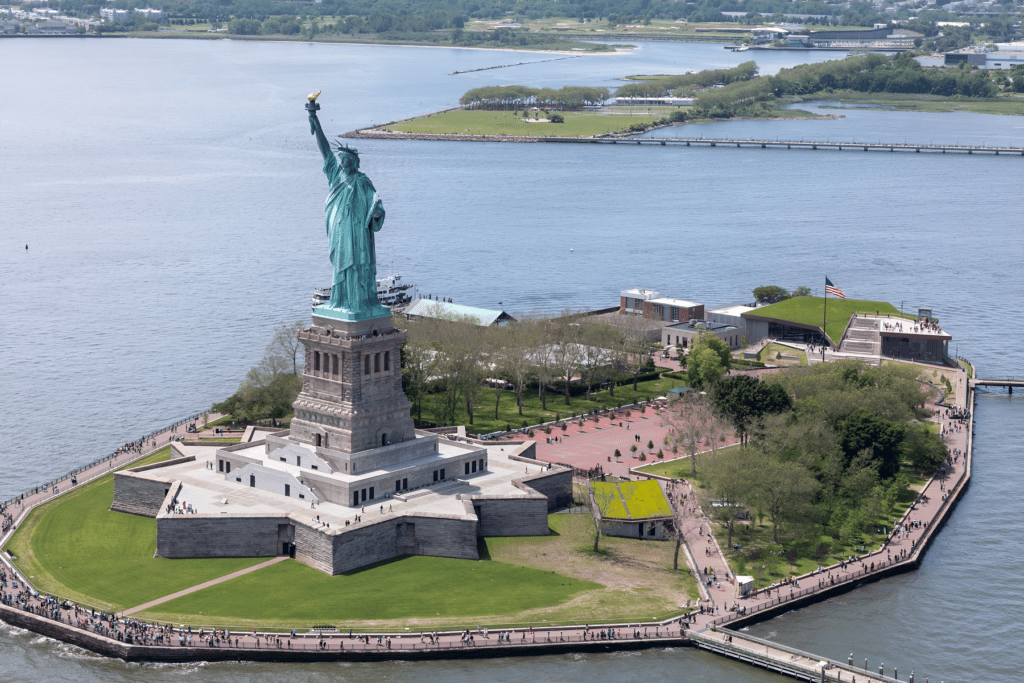The Statue of Liberty, located on Liberty Island in New York Harbor, stands as a universal symbol of freedom and democracy. Recognized worldwide, this iconic monument has a rich history, and an impressive structure, and remains a major attraction. Here, we’ll explore its history, structure, operating hours, and the latest developments surrounding the statue.
A Brief Introduction
The Statue of Liberty, gifted by France to the United States in 1886, commemorates the centennial of American independence and celebrates the enduring friendship between the two nations. Standing at a height of 305 feet, it is not only a work of art but also a powerful symbol of liberty and human rights. The statue has welcomed millions of immigrants as they arrived in America, representing hope and new beginnings.
History of the Statue of Liberty
French sculptor Frédéric Auguste Bartholdi designed the Statue of Liberty, while engineer Gustave Eiffel helped with its structure. The construction began in France in 1875, and it took over a decade to complete. In 1885, the statue was shipped in 350 pieces to the United States. The pedestal, financed through donations from Americans, was completed the following year. President Grover Cleveland dedicated the statue on October 28, 1886.
Over the years, the statue has undergone several restorations, including a major one in 1984 to prepare for its centennial. In 1986, it was added to the list of UNESCO World Heritage Sites, marking its global significance. Lady Liberty’s torch, originally made of copper, was replaced with a gold-leaf version during the restoration.
Structure and Design
The Statue of Liberty stands 151 feet from base to torch, but including the pedestal, the entire structure reaches 305 feet. The copper sheets that form the statue’s exterior are only 2.4 mm thick and weigh 204 metric tons. Lady Liberty holds a torch in her right hand, symbolizing enlightenment, and a tablet in her left hand inscribed with the date of American independence, July 4, 1776. Her broken chains at her feet signify freedom from oppression.
Gustave Eiffel, famous for designing the Eiffel Tower, created the internal iron framework. This structure allows the statue to withstand winds and remain durable over time. The green patina, which developed over the years due to oxidation, actually protects the copper underneath, preserving the statue.
Collection and Museum
The Statue of Liberty Museum opened in 2019 and offers a comprehensive collection of artifacts related to the statue’s history. The museum displays the original torch, which was replaced in 1984, and interactive exhibits that tell the story of the statue’s conception, construction, and symbolic importance. Visitors can also explore the museum’s immersive theater, which provides a deeper understanding of Lady Liberty’s global impact.
The museum also focuses on the ideals of liberty and immigration. It includes personal stories of immigrants and their experiences arriving in the United States, connecting the monument to America’s rich history as a nation of immigrants. The museum’s design allows for an engaging and educational experience.
Opening and Closing Times
The Statue of Liberty is open to visitors year-round except for Thanksgiving and Christmas Day. Ferry services, which transport visitors to Liberty Island, typically operate from 8:30 AM to 4:00 PM, but the times vary by season. The last ferry back from the island usually departs by 5:00 PM, giving visitors ample time to explore the island and the museum.
Those who wish to access the crown must make reservations in advance due to limited capacity. Crown access offers breathtaking views of New York Harbor and is a popular feature for many tourists. The pedestal also offers panoramic views of the city and the surrounding waters.
Updates
In recent years, the Statue of Liberty has seen an increase in visitors as travel restrictions ease. Restoration projects continue to ensure the longevity of this historical landmark. The National Park Service has been working on preserving both the statue and Liberty Island, especially as climate change poses a potential threat to its structure.
There are ongoing discussions about improving accessibility to the statue. A new ferry terminal is under consideration to accommodate the growing number of visitors. In 2023, the museum welcomed its millionth visitor, marking a significant milestone since its opening. Special exhibitions are frequently updated to keep the story of the Statue of Liberty relevant to modern audiences.
Recent Developments
Environmental concerns are becoming more pressing as rising sea levels and stronger storms threaten Liberty Island. The National Park Service has ramped up efforts to mitigate potential damage from extreme weather conditions. Engineers are looking at ways to protect the island’s infrastructure and the statue itself.
Moreover, the statue has been featured in global awareness campaigns about human rights and immigration, reinforcing its symbolic role in today’s political landscape. Events and ceremonies held on Liberty Island have highlighted themes of freedom, justice, and the need for global cooperation.

